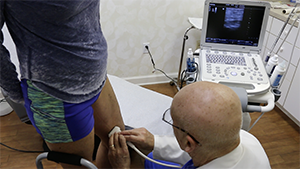Gina’s varicose veins are now a thing of the past thanks to phlebectomy (a technique to remove varicose veins) and venous ablation with Gabor Kovacs, M.D., F.A.C.S., a board-certified vascular and general surgeon at the Vein Care Center of Amelia Island.
Bulging varicose veins were causing Gina embarrassment on both a personal and professional level. As a fitness instructor, she often had to explain to her students about the unsightly purple-bluish veins on her legs.
“In the summer, sometimes people would see my legs, and they would be like, ‘What’s that?’ because the veins were bulging so much,” Gina says. “And you kind of sink into your shell and you say, ‘Well, they’re varicose veins.’ But now that they’re gone, it just feels great.”
What are Varicose Veins?
Varicose veins affect roughly 25% of U.S. adults (about 30 million people). Women are more likely to have varicose veins on their legs than men by a ratio of 60/40. Varicose veins (also known as venous insufficiency) show up as large, bulging, contorted blue or dark purple veins in the legs and pelvis. They typically extend from the thigh down to the ankle or any part of the leg.
 Varicose veins can negatively affect self-esteem, confidence, and self-image. People with varicose veins often feel ashamed about their legs and feet and may go to great lengths to avoid showing them in public.
Varicose veins can negatively affect self-esteem, confidence, and self-image. People with varicose veins often feel ashamed about their legs and feet and may go to great lengths to avoid showing them in public.
If left untreated, varicose veins can lead to:
- Leg fatigue and heaviness
- Nagging, throbbing leg pain and achiness
- Cramping or swelling in the legs
- At times, restless leg syndrome
Varicose (literally meaning “swollen”) veins can make it difficult to stand for prolonged periods and cause swollen ankles, skin darkening, and skin wounds. In extreme cases, varicose veins may break open or ulcers may appear on the skin.
What Causes Varicose Veins?
 Pregnancy can predispose women to varicose veins, but the leading causes are usually either genetic or occupational. People with parents or other close relatives who had varicose veins are more likely to develop them. And individuals who spend a lot of time on their feet at work will be more at risk of getting varicose veins as well.
Pregnancy can predispose women to varicose veins, but the leading causes are usually either genetic or occupational. People with parents or other close relatives who had varicose veins are more likely to develop them. And individuals who spend a lot of time on their feet at work will be more at risk of getting varicose veins as well.
Under normal conditions, one-way valves in the leg work to prevent the blood from remaining stagnant or flowing backward; they work against gravity to keep blood moving toward the heart. When the valves fail, blood backs up into the veins causing an overload of pressure and swelling.
The surplus pressure expands the veins so that they cannot close properly. The result is that the veins stay bloated with blood, thereby creating varicose veins. Venous insufficiency can also occur from a past blood clot in the legs.
What is a Phlebectomy and How is It Performed?
 Phlebectomy (also known as microphlebectomy, or ambulatory phlebectomy) is a minimally-invasive outpatient procedure that uses a small scalpel or needle to remove varicose veins that lie just beneath the surface of the leg.
Phlebectomy (also known as microphlebectomy, or ambulatory phlebectomy) is a minimally-invasive outpatient procedure that uses a small scalpel or needle to remove varicose veins that lie just beneath the surface of the leg.
The procedure involves several tiny incisions in the skin through which the varicose vein is removed. Stitches usually are not needed, and the procedure typically does not require a stay in the hospital. It may be done in the doctor’s office with local anesthesia.
Phlebectomy might be administered along with another treatment for varicose veins, including venous ablation, ligation and stripping, or radiofrequency treatment.
“I came to Vein Care of Amelia Island for bulging veins. I had a phlebectomy and venous ablation done, and I am so thrilled with the results,” says Gina.
What is Venous Ablation?
Endovenous ablation uses energy to burn off and close varicose veins. Doctors use it to help ease symptoms such as pain, swelling, and irritation. Ablation is safe, less invasive than surgery, and leaves virtually no scars.
Endovenous thermal ablation, also called laser therapy, is a newer technique that uses a laser or high-frequency radio waves to create intense local heat in the affected vein.
Heat is directed through a catheter to close up the targeted vessel. This treatment closes off the problem veins but leaves them in place, so there is minimal bleeding and bruising. Compared with ligation and stripping, many patients find that endovenous thermal ablation results in less pain and a faster return to normal activities with similar cosmetic results.
Gina’s experience was a case in point. “I’m a fitness instructor, and every time I would get off the bike, my veins would bulge even more. It’s so nice that they’re gone,” she says. “I was told that healing might take a long time. However, I didn’t have any pain. I was good to go and was walking miles the very day I had them done.”
Gina also appreciated the warm welcome and support she received from the entire Vein Care Center of Amelia Island team. “The staff was very friendly,” she says. “I felt very welcomed and received over-the-top care. Come in and see, and talk with them first. And look at my legs before and after. Everyone in my classes says, ‘Wow, that looks amazing.’ I show them the before and after pictures, and a lot of them remember them. But now the varicose veins are gone.”
